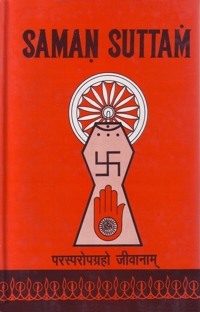35. Dravy Sutra
PRECEPTS ON THE SUBSTANCE
Dhammo ahammo agasam, kalo puggala jantavo.
Esa logo tti pannatto, kinehim varadamsihim. (624)The supreme visioned Jinas have described the universe to be constituted of six substances viz. Dharma (medium of motion), Adharma (medium of rest), Akasa (space), kala (time), Pudgala (matter) and Jiva (soul). (624)
Agasakalapuggala-dhammadhammesu natthi jivaguna.
Tesim acedanattam, bhanidam jivassa cedanada. (625)The substances, Akasa, kala, Pudgala, Dharma and Adharma, do not possess the attributes of the Jiva (i.e. devoid of life) and they therefore have been called Ajivas (non-living). The attribute of Jiva is consciousness. (625)
Agasakalajiva, dhammadhamma ya muttiparihina.
Muttam puggaladavvam, jivo khalu cedano tesu. (626)Aksa, Kala, Jiva, Dharma and Adharma are incorporeal, where as Pudgala (matter) is corporeal. Of these, only the soul substance is conscious. (626)
Jiva puggalakaya, saha sakkiriya havamti na ya sesa.
Puggalakarana jiva, khamdha khalu kalakarana du. (627)The Jiva (soul), the Pudgala (matter), these two substances are active, while the rest are inactive. The external cause of the activity of soul is Karmic matter and of the activity of matter is the substance kala (time). (627)
Dhammo ahammo agasam, davvam ikkikkamahiyam.
Anamtani ya davvani, kalo puggala jamtavo. (628)Dharma, Adharma and Akasa are singular in number, Kala, Pudgala and Jiva-these three are infinite in number. (628)
Dhammadhamme ya do.vee, logamitta viyahiya.
Logaloge ya agase, samae samayakhettie. (629)Dharma and Adharma-bothe these substances have their extension throughout the universe, while Akasa (space) pervades the universe and beyond the universe. Kala pervades only the time region. (629)
Annonnam pavisamta, dimta ogasamannamannassa.
Melamta vi ya niccam, sagam sabhavam na vijahanti. (630)These six substances (dravyas) are co-extensive in the same space and accommodate one-another, they are mixed up with one another from the time infinite. However, they maintain their identity without loosing their respective nature. (630)
Dhammatthikayamarasam, avannagandham asaddamapphasam.
Logogadham puttham, pihulamasamkhadiya-padesam. (631)Dharmastikaya is devoid of the attributes like taste, colour, smell, sound and touch. It pervades universe, it is independent, huge and has innumberable pradesas, i.e., spacepoints. (631)
Udayam jaha macchanam, gamananuggahayaram havadi loe.
Taha jivapuggalanam, dhammam davvam viyanehi. (632)Just as water is helpful in the movement of fishes so is the Dharma in the movement of souls and matter. (632)
Na ya gacchadi dhammatthi, gamanam na karedi annadaviyas.
Havadi gati sa ppasaro, jivanam puggalanam ca. (633)Dharmastikaya does not move itself nor cause other things to move; but it is an all pervading medium of motion for the living and non-living bodies. (633)
Jaha havadi dhammadavvam, taha tam janeha davvamadhammakkham.
Thidikiriyajuttanam, karanabhudam tu pudhaviva. (634)Know that just as Dharma is substance, so is the Adharma. It is helpful in bringing about the rest of the Jivas and Pudgalas capable of being static. (634)
Ceyanarahiyamamuttam, avagahanalakkhanam ca savvagayam.
Loyaloyavibheyam, tam nahadavvam jinuddittham. (635)The substance space is devoid of consciousness, is incorporeal, accommodating and all-pervading. It is of two types one is lokakasa i.e., (space within the universe) and Alokakasa i.e., space beyond the universe. (635)
Jiva ceva ajiva ya, esa loe viyahie.
Ajivadesamagase, aloe se viyahie. (636)It is explained that the loka, i.e., universe consists of living and non-living substances, whereas Aloka consista of only a part of one non-living substance i.e., (space) (636)
Pasarasagamdhavanna-vvadiritto agurulahugasamjutto.
Vattanalakkhanakaliyam, kalasaruvam imam hodi. (637)The substance time is devoid of attributes like touch, tast, smell and colour and properties like heaviness and lightness. It is characterized by mutation. (636)
Jivanam puggalanam, huvamti pariyattanai vivihai.
Edanam pajjaya, vattamte mukkhakalaadhare. (638)The multiple mutations and various modes of the soul and matter are mainly due to time substance. (638)
Samayavaliussasa, pana thova ya adia bheda.
Vavaharakalanama, nidittha viyaraehim. (639)From practical view-point the time is meansured by diverse units like avali (closing and opening of eye-lids) Ucchvasa (time taken in an exhalation), Prana (taken in one respiration) and stoka (second). It is asserted by the Jinas. (639)
Anukhamdhaviyappena du, poggaladavvam havei duviyappam.
Khamdha hu chappayara, paramanu ceva duviyappo. (640)The substance matter is of two kinds-in the form of an atom (paramanu) and in the form of molecules. Molecules are of six kinds, while the atoms are of two kinds. (640)
Aithulathula thulam, thulasuhumam ca suhumathulam ca.
Suhumam aisuhumam idi, dharadiyam hodi chabbheyam. (641)Gross-gross, gross, gross-fine, fine-gross, fine and fine-fine, these are the six kinds of the aggregate matter (skandha Pudgal). The earth etc. are its six examples. (641)
Pudhavi jalam ca chaya, caurimdiyavisaya-kammaparamanu.
Chavvihabheyam bhaniyam, poggaladavvam jinavarehim. (642)The earth, the water, the shadow, the objects of four senses, (except sight), the Karmic matter and the atoms, these are the six different forms of matter. (642)
Antadimajjahinam, apadesam imdiehim na hu gejjham.
Jam davvam avibhattam, tam paramanum kahamti jina. (643)Such a substance, as is devoid of dimensions, i.e., two extremes and the middle, unextended, not to be perceived by the sense-organs and indivisible, has been called atom by the Jinas. (643)
Vannarasagamdhaphase, puranagalanai savvakalamhi.
Khamdam iva kunamana, paramanu puggala tamha. (644)Like the molecules, the atoms also possess the attributes of colour, taste, smell and touch, they remain everchanging by getting conjoined and disjoint. They therefore are called Pudgala. (644)
Panehim caduhim jivadi, jivadi, jivassadi jo hu jivido puvvam.
So jivo, pana puna balamimdiyamau ussaso. (645)That which lives, will live and has lived through the instrumentality of the four types of vitalities (prana) is called soul (Jiva) and the four types of vitality are life-force, organs, life-span and respiration. (645)
Anugurudehapamano, uvasamharappasappado ceda.
Asamuhado vavahara, nicchayanayado asamkhadeso va. (646)From practical point of view, a soul has a small or big size according to the size of the body, on account of its undergoing expansion and contraction. But from real view point, it is possessed of innumerable space-points (Pradesas). (646)
Jaha paumarayarayanam, khittam khire pabhasayadi khiram.
Taha dehi dehattho, sadehamattam pabhasayadi. (647)Just as a ruby thrown into milk illuminates the whole milk only, so also an embodied soul illuminates its own body only. (647)
Ada nanapamanam, nanam neyappamanamuddittham.
Neyam loyaloyam, tamha nanam tu savvagayam. (648)The soul is co-extensive with cognition, cognition is co-extensive with what is to be congnised, loka and aloka are cognizable, therefore cognition is all-pervasive. (648)
Jiva samsarattha, nivvada cedanappaga duviha.
Uvaogalakkhana vi ya, dehadehappavicara. (649)Jiva is of two kinds: mundane and emancipated; both of them are sentient and endowed with consciousness; even then the mundane souls have bodies while the emancipated ones do not. (649)
Pudhavijalateyavau-vanapphadi vivihathavareimdi.
Bigatigacadupamcakkha, tasajiva homti samkhadi. (650)The earth, the water, the fire, the air and the plants are various kinds of immobile beings with one sense organ. The mobile beings like conches etc. are possessed of two, three, four and five senseorgans. (650)
 Jinendra Varni
Jinendra Varni

